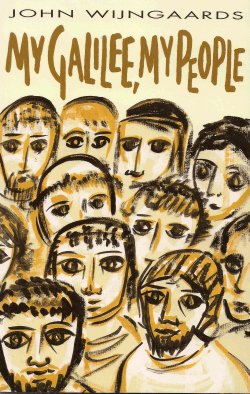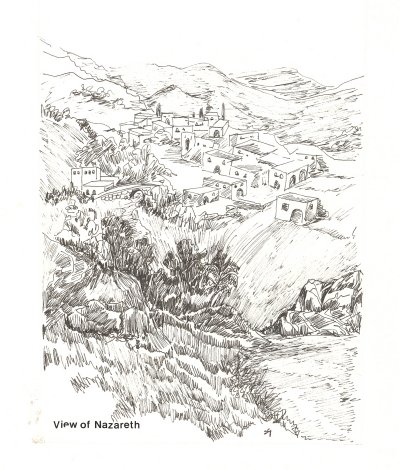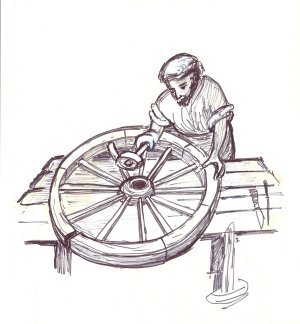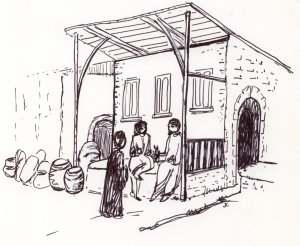
 Jesus' stay in the business town of Capernaum did not make him forget
the people in the country side. We are told that he went round 'visiting all
the towns and villages'. (1) He visited all the villages around Capernaum. (2)
People would put their sick on the ground in open places, begging him to allow
them to touch the hem of his garment, 'in whatever villages, towns or small
hamlets Jesus entered'.(3) And when Jesus sent his disciples out in twos to
preach the Kingdom, he expected them to call on even the tiniest village. (4)
Jesus' stay in the business town of Capernaum did not make him forget
the people in the country side. We are told that he went round 'visiting all
the towns and villages'. (1) He visited all the villages around Capernaum. (2)
People would put their sick on the ground in open places, begging him to allow
them to touch the hem of his garment, 'in whatever villages, towns or small
hamlets Jesus entered'.(3) And when Jesus sent his disciples out in twos to
preach the Kingdom, he expected them to call on even the tiniest village. (4)
Jesus knew what villages were like. He himself had lived in Nazareth.
What kind of place was Nazareth?
It was such a small hamlet that it is not mentioned in any historical sources outside the Gospels. Not once is it referred to in the Old Testament books. Flavius Josephus, who describes the war between the Jews and Romans in Galilee (67-68 AD), mentions 200 Galilean towns and villages by name. Nazareth is not among them. Also the Talmud and other contemporary Jewish sources do not mention it; its name only occurs in some second-century texts.
From this we can already deduce that Nazareth was indeed small; so small and insignificant, in fact, that even most Galileans had never heard of it. It explains Nathanael's reaction when Peter told him: 'We have met the person announced by Moses and the prophets. It is Jesus, son of Joseph, from Nazareth'.
'From Nazareth?!' Nathanael exclaimed. 'Can anything good come from Nazareth? (5)
It prepares us for the findings of archeological studies.

The precise location of Nazareth has been preserved for us by Jewish settlements there after the wars with Rome. Nazareth lay in the lower hills just north of the plains of Esdraelon valley. It lay close to two large cities: Sephphoris, three miles to its north and Japha, one-and-a-half miles to its southwest. The major road from Egypt to Damascus ran six miles south of Nazareth through the valley of Esdraelon. Nazareth's position in a small valley of its own, tucked away behind stony hills (see the map of Galilee on page 19), kept it hidden and out of view.
Excavations show that Nazareth was not a recent foundation. Tombs have been found with pottery and ornaments that can be dated back to the Middle Bronze Age (2000 - 1550 BC), the Late Bronze Age (1550 - 1200 BC) and the Iron Age (1200 - 587 BC). Different populations must have lived here, spanning the transition from the original Canaanites to the Israelites.
The tombs do not point to numerous inhabitants. The tombs have only been preserved better than elsewhere because Nazareth lay on limestone from which they were hewn. Nazareth had to remain small for two reasons: the surrounding area was stony and arid, yielding no more than meagre crops; and it possessed only one tiny well, with a scant supply of water.
Excavations show that in Jesus' days Nazareth lay on a small limestone outcrop that still forms the centre of Nazareth today. (6) It occupied an area of about a hundred yards long by fifty yards wide. Not more than twenty to thirty houses stood on this site (see the previous page for a reconstructed view). Underneath the houses and around them, caves had been hewn in the rock which served as silos to store grain, as cellars for wine and as cisterns to collect rain water. (7)
Nazareth's underground storage caves are a somewhat unusual feature. They were a bonus for the village, no doubt due to the favourable nature of the rock it stood on. The purposes for which the caves were used, show that the inhabitants of Nazareth lived from agriculture: from vineyards, olive groves, the cultivation of grains and some other basic crops. Jesus' Nazareth was a cluster of twenty farm houses, probably arranged in close formation to provide a maximum of protection against thieves and robbers. It was a mere speck on the map of Galilee, a place no one would have noticed if it had not been Jesus' home. 'Of Nazareth' was Jesus' family name. (8)
The people of Nazareth must, in fact, have constituted a clan of interrelated families. Mary, Jesus' mother, lived in Nazareth before her marriage to Joseph. (9) Joseph must have lived in Nazareth too, for he 'took her to his home' to complete their marriage. (10) During one of Jesus' visits to Nazareth the people say about him:
'Where did he get this wisdom and miraculous powers?
Isn't he the builder's son?
Is Mary not his mother and aren't James, Joseph, Simon and Jude his brothers?
Do all his sisters not live among us?
Where did he get all this from?' (Matthew 13,54-56)
If, as we may presume, his brothers and sisters (= Jesus' cousins in Semitic speech) were by then married and lived in their own homes, Jesus was related to half the population of Nazareth!
Disaster was to strike the village hardly forty years later, when the Roman armies ravaged the countryside in their campaign against nearby Japha (67 AD). Flavius Josephus recounts that the Romans placed 7000 troops in Sephphoris who systematically plundered the surrounding valleys, killing all the able-bodied men and selling the others as slaves. Villagers found refuge in the fortress of Japha for some time; when this city fell, all survivors met a similar fate. (11)
What happened to Jesus' relatives?
Some must have died with their fellow Galileans. Others escaped because, as the early historian Eusebius claims, (12) they had scattered from Nazareth all over the land. We know for a fact that some were part of the early Christian congregation in Jerusalem. One of their first bishops, James, was called 'a brother (relative) of the Lord' (13) and Cleophas(14) was also related to Christ, as tradition tells us. Some of Jesus' relatives worked as Christian missionaries.(15) It is likely that the names of Jesus' brothers quoted above - James, Joseph, Simon and Jude - were so easily recalled in tradition because the early Christians knew them.
Did some of Jesus' family return to Nazareth after the wars with Rome?
The evidence seems against it.
We know that a priestly clan from Jerusalem settled there who made it a stronghold of Jewish, anti-Christian resistance.(16) We do find the story of St.Konon, who died as a martyr in Pamphylia in 249 AD. He is said to have stated before a Roman judge: 'I am from Nazareth in Galilee. I am a relative of Christ whom I and my ancestors have served'. (17) But his origin from Nazareth does not prove that he actually lived there; any more than Joseph's being 'from Bethlehem' (18) proves that he lived in Bethlehem. Epiphanius heard from Joseph of Tiberias (359 AD) that no Greek, Samaritan or Christian lived in Nazareth, 'because the Jewish inhabitants do not tolerate any stranger among them'. (19)
We have no continuous Christian tradition in Nazareth. Moreover, no sure archaeological evidence was found of Christian veneration there until the fourth century. This means we cannot be sure that the present shrines in Nazareth mark exact location of Mary's or Joseph's home; (20) or, for that matter, of the synagogue in Jesus' time.

The village 'carpenter', the handyman,
did a
thousand and one odd jobs, requiring a variety of skills.
He was an
indispensable member of any village community.
However, this does not constitute much of a loss. The area of ancient Nazareth is so small and so well defined, that the exact location of one home or the other makes little difference. They were all so close together: Mary's ancestral home, the house of Joseph and Mary where Jesus grew up, the small building that served as synagogue and the houses of relatives and friends. All were within shouting distance.
The layout of a village like Nazareth, we can be sure, had not been planned. There was no real centre; only two focal points: the house of prayer and the well, four hundred yards south of the village. There were no proper streets; only passages between houses or their compound walls.
It is commonly believed that Jesus was a carpenter. The word used in the Gospels, however, actually means builder, it designates any craftsman who works in wood, stone or metal. In a place like Nazareth it included everything in the nature of building or maintenance. Jesus was called the 'son of Joseph, the builder (21) or simply 'the builder' (22). In our terms he was building contractor, stone mason, carpenter and smith all rolled into one. He was the village handyman.
Jesus knew all the houses in Nazareth, because he had either built them or repaired them. A peasant's house usually consisted of just one rectangular room, of about 12 to 16 square yards (12 feet x 14 feet). In Nazareth the walls were built with small limestone blocks. The roofs were constructed by laying brushwood across sycamore beams, covering the surface with compressed and dried mud. The house had an entrance that could be closed by a wooden door, and one or two small, square windows.
The floor space inside the room was divided into two parts. The area close to the door was made of stamped-down earth. Here stood the household utensils and the farmer's tools. Here was the fireplace, if cooking or heating needed to be done indoors. The other half of the floor consisted of a slightly raised, stone platform for family activities, such as eating and sleeping.
A low boundary wall in front of the house or beside it was used to enclose domestic animals during the night. Here, too, were the cisterns for rainwater and the silos discovered in the excavations. Stone steps led from inside the enclosure to the roof. From here steps also led down into the cellars, if a house possessed one.
Jesus' experience as a builder shows up in some of the comparisons he uses.
* A man may well build a house on sand during the dry season and believe all is well. But when the rain and the wind lash against the house, the walls will collapse. Only a house built on rock will stand. (23)
* Jesus gave Simon the Aramaic name Cephas, that is: rock ('Peter' in Greek); he wanted to build his Church on Peter's strength. (24)
*A man who wants to build a two-story house must ¦ realise that the foundations and the walls need to be specially reinforced. He should calculate this extra cost beforehand, otherwise he will not be able to complete the building and his neighbours will laugh at him. (25)
* An unwieldy stone rejected by the builders as unsuitable for the walls, may well turn out to be excellent as a corner stone. (26) Then it can give support to two or three walls at once.

Since building materials lacked today's strength (there was no steel or cement),
the solidity of a house depended on how stones and wood were fitted together.
It required careful planning and real craftsmanship.
The people of Nazareth worked on the land. They either possessed an orchard or vineyard themselves, or held such properties as tenants for rich landowners, as I will explain later (in chapter seven). Jesus too must have spent many days working on the land when all hands were required, to prune vines or gather in the harvest. But at other times he went round doing a hundred different jobs: repairing a roof, hewing out a cistern, carving a new plough. The people may have paid him in kind; with a measure of grain, oil or figs.
The women in the village would share in the farming as much as they could. Part of their day was spent in fetching water from the well, grinding corn and preparing food for the family. The menfolk would return at nightfall. They would secure their goats and sheep, and join the women for the evening meal. The daily routine was quite demanding since even simple jobs required a lot of hard, physical work. There was little time for leisure. Contacts with outsiders were limited to visits from family and friends living in other towns, and to the annual pilgrimage to Jerusalem.
In almost every respect Jesus must have lived like the other people in his village. But there was a difference. From an early age he must have done a lot of thinking and praying. Nazareth lay in a secluded place, and yet it looked out upon a wider world. During the few occasions I have been privileged to visit Nazareth, I spent time roaming the countryside around it. What struck me is the magnificent views it offers. From a summit above the village one looks south across the beautiful plain of Jezreel, west to Mount Carmel on the Mediterranean coast and east to Mount Tabor. On a clear day one can even see, in the far north, the snow-capped tip of Mount Hermon. Jesus must have sat there and thought about the world he belonged to.
Luke has preserved a tradition according to which the twelve-years old boy Jesus asked amazing questions of the scribes in the Temple of Jerusalem.(27) They must have been related to Scripture. Jesus had learned to read and write. Every Jewish community that possessed a synagogue would make sure a number of intelligent lads were taught the Hebrew alphabet so that they could become readers on the sabbath day. Jesus was one of them.
Jesus studied nature, 'the work of his Father',(28) and the Father's word, the inspired Scriptures.(29) But he also studied people. For people would be his main concern.
The people of Nazareth had heard news of what Jesus was doing in Capernaum. His obvious success as a preacher and healer intrigued them. It was something they had never expected from their quiet, unassuming 'handyman'! What was he up to? Where did he get his unusual powers from?
During one of his visits to his home village, Jesus joined them on the sabbath for prayer in the synagogue. When he was asked to read, he took the opportunity to explain his mission. He chose (30) Isaiah 61,1-2 for this purpose.
'What I am doing, I do through the Father's power.
He has called me as he called so many prophets in the past.'
'The Father sent me to ordinary people with a message that will make them happy.'
'Through me the Father begins the messianic liberation promised by his prophets.'
Jesus states clearly that he is the Messiah the Jews were waiting for - something his relatives may have found hard to swallow. And he says that his mission is to help people. The liberation and salvation of people is his priority. This, too, irked his former companions since he seemed to favour 'outsiders'.
The prophecies of Isaiah Jesus quoted from, speak a lot about restoring Israel's fortunes as a nation and of rebuilding Jerusalem in all its glory.(31) Jesus deliberately chose the section that speaks of freeing and saving the people that are in need: the poor, the blind, the oppressed, the tenants who are in prison because they cannot pay off their debt. Jesus did not come to create new institutions. He came for people.
'Why don't you perform miracles among us, as you did in Capernaum?' they wanted to know.
'I would, if only you would believe in me', he replied. (32) 'Why do you do more for strangers, for 'outsiders' than for us?' they insisted.
'The outsiders have faith. Faith is more important to the Father than blood relationship. That is why Elijah provided food for the widow who lived in Sidon, and not for widows in Israel. Elisha cured Naaman, a leper from Syria, but no Jewish lepers. (33) Moreover, prophets are never recognised in their home land.' (34)
The people became angry. They dragged him out of the synagogue and 'took him to the top of the hill on which their village was built. They wanted to throw him down the cliff. (35) The meaning of this is clear. They considered his messianic claim a blasphemy. They decided to punish him with the prescribed penalty, namely stoning the blasphemer to death. Such stoning was begun by throwing the culprit down from some height, then crushing him with stones. The natural place for such an execution was a steep cliff on one side of the village. Jesus, however, walked away through the middle of the crowd and left.
The violent reaction of Jesus' village folk gives us an idea of the fanaticism with which the ordinary people clung to their religious convictions.(36) For the early Christians the event foreshadowed the even more tragic rejection of Jesus by Israel as a whole. Jesus' words about a prophet not being welcome in his own land, would take on much wider implications. For Jesus, however, it was a question of principle that he had come not to gratify his own relatives, but to serve people in need. They should have known.
Even before the clash in Nazareth itself, he had made this plain. While he was teaching a crowd of people in his house in Capernaum, (37) a group of his relatives, accompanied by his mother, tried to get priority attention. Probably they expected Jesus to dismiss the others and entertain them instead.
'See, your mother and your brothers and sisters are standing outside. They're asking for you!'
'Who is my mother? Who are my relatives?' Jesus replied. Then pointing at the people sitting around him he said: 'Look! Here are my mother and my relatives. Whoever does the will of God is my brother, my sister, my mother.' Mark 3,32-35
One of the radical demands of Jesus' mission was that he value people in their own right; not because they were related to him or shared a common interest. The first priority in God's Kingdom was, and is, people.
1. The Gospel records this incident:
A woman said to him: 'Blessed the womb that bore you and the breasts that you sucked.'
Jesus replied: 'Rather, blessed are those who listen to God's word and obey it!' Luke 11,27-28.
What is Jesus saying here about his relationship to people?
2. In the light of Jesus' reception in Nazareth, and later in Jerusalem, what did these words mean to Jesus?
'The stone which the builders rejected has become the corner stone.
This is God's doing; it's a wonderful thing in our eyes.' Psalm 118; see Matthew 21,42.
3. In the light of what Jesus said about his mission in Nazareth (read Luke 4,16-21), comment on this passage from Vatican II:
'The joys and the hopes, the sorrows and the worries of the people of our time, especially of those who are poor or in any way afflicted, these too are the joys and hopes, the sorrows and worries of the followers of Christ. Indeed, nothing genuinely human can fail to raise an echo in their hearts.' The Church in the Modern World
| 1. Matthew 9,35; cf. Luke 8,1. | 2. Mark 6,6. | 3. Mark 6,56. |
| 4. Matthew 10,11; cf. Luke 10,1. | 5. John 1,45-46. |
6. Some archaeologists thought that the tombs found in the central part, would exclude it from being the site of the ancient village. Jews would not live in a cemetery. The excavations of S.Bagatti (1960 - 1968) established that the tombs are much older. In all likelihood they were no longer known as tombs in Jesus' day. At that time the cemetery lay more to the south.
7. The discovery of the underground caves in the Middle Ages led to the belief that the people of Nazareth lived in them (Burchard of Mount Sion in 1283 AD). This was not the case. The people lived in simple stone houses which stood over the cellars and in between the water cisterns. S.LOFFREDA, 'Nazareth à l'époque évangélique', Le Monde de la Bible, no 56, Paris 1980.
8. The inscription on Jesus' cross, in three languages: Hebrew, Latin and Greek, identified the convict as 'Jesus of Nazareth'; John 19,19-20.
| 9. Luke 1,26. | 9. Luke 1,26. | 10. Matthew 1,18.20.24. |
11. Jewish Wars III 4,i; 7,32.
12. EUSEBIUS (265-340 AD), History of the Church I 7,14; edition by LAWLOR and OULTON, London 1927.
| 13. Galatians 1,19. | 14. Luke 24,18. | 15. 1 Corinthians 9,5. |
16. S.K.KLEIN, Beiträge zur Geographie und Geschichte Galiläas, Leipzig 1909, p.94.
17. A.P.KERAMEUS, Analekta, Petersburg 1898, vol. 5, p.386.
18. Luke 2,2-3. 4.
19. Against the Heretics, XXX 11,9-10; C.KOPP, Die heiligen Statten der Evangelien, Regensburg 1959, p. 90.
20. For contrary claims, read F.MANNS and J.DAOUST in Le Monde de la Bible, no 16, Paris 1980, pp.16 - 28.
| 21. Matthew 13,55. | 22. Mark 6,3. | 23. Matthew 7,24-27; Luke 6,47-49. |
| 24. John 1,42: Matthew 16, 18. | 24. John 1,42: Matthew 16, 18. | 25. Luke 14,28-30. |
| 26. Mark 12,10. | 27. Luke 2,41-52. | 28. Mathew 6,25-32; John 5,17. |
29. Compare John 5,39-40.
30. Luke 4,17. The imperfect form of the Greek verb shows it means: 'he looked for', not 'he found'.
31. See Isaiah 60,1-22; 61,10 - 62,12.
| 32. Mark 6,5-6. | 33. Luke 4,25-27. | 34. Luke 4,24. | 35. Luke 4,29. |
36. There may have been political motives as well as I will explain later.
37. Mark 3,31; see 3,20.